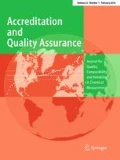Abstract
Proficiency testing or external quality control provides additional means to ensure the quality of laboratory testing results. Various methods can be considered in practice to fulfill this objective. The most commonly applied are comparison of laboratory results with reference or consensus values. In this work, we study the concordance between these schemes based on the review of a large dataset corresponding to clinical chemistry proficiency testing results. The analysis is carried out by using several statistical methodologies (diagnostic tests, contingency tables, and test of hypothesis). Results indicate that the conclusions obtained from these schemes can be in some cases (several analytes) markedly different. This is possibly because some statistical assumptions to apply PT based on consensus values are violated.

Similar content being viewed by others
References
ISO/IEC 17043 (2010) Conformity assessment-general requirements for proficiency testing. Standard, International Organization for Standardization, Geneva
Medeiros de Albano F, Schwengber ten Caten C (2014) Proficiency tests for laboratories: a systematic review. Accred Qual Assur 19:245–257
Szewczak E, Bondarzewski A (2016) Is the assessment of interlaboratory comparison results for a small number of tests and limited number of participants reliable and rational? Accred Qual Assur 21(2):91–100
Koch M, Baumeister F (2012) On the use of consensus means as assigned values. Accred Qual Assur 17(4):395–398
PROASECAL SAS (2019) https://www.proasecal.com/
Hund E, Massart DL, Smeyers-Verbeke J (2000) Inter-laboratory studies in analytical chemistry. Anal Chim Acta 423(2):145–165
Wong S (2005) Evaluation of the use of consensus values in proficiency testing programmes. Accred Qual Assur 10(8):409–414
Baldan A, van der Veen AM, Prauß D, Recknagel A, Boley N, Evans S, Woods D (2001) Economy of proficiency testing: reference versus consensus values. Accred Qual Assur 6(4–5):164–167
Wong S (2007) A comparison of performance statistics for proficiency testing programmes. Accred Qual Assur 12:59–66
ISO 13528 (2015) Statistical methods for use in proficiency testing by interlaboratory comparison. Standard, International Organization for Standardization, Geneva
Hollander M, Wolfe DA (1999) Nonparametric statistical methods. Wiley, London
Zar J (1999) Biostatistical analysis. Pearson Education India, Bengaluru
Lalkhen AG, McCluskey A (2008) Clinical tests: sensitivity and specificity. Contin Educ Anaesth Crit Care Pain 8(6):221–223
Reitsmaa J, Glasa A, Rutjesa A, Scholtenb R, Bossuyta P, Zwindermana A (2005) Bivariate analysis of sensitivity and specificity produces informative summary measures in diagnostic reviews. J Clin Epidemiol 58:982–990
Kim S, Lee W (2017) Does McNemar’s test compare the sensitivities and specificities of two diagnostic tests? Stat Methods Med Res 26(1):142–154
Wong S (2016) Review of the new edition of ISO 13528. Accred Qual Assur 21(4):249–254
Willink R (2005) Forming a comparison reference value from different distributions of belief. Metrologia 43(1):12
Razali N, Wah Y (2011) Power comparisons of Shapiro-Wilk, Kolmogorov-Smirnov, Lilliefors and Anderson-Darling tests. J Stat Model Anal 2(1):21–33
Carobbi C (2017) A modified ISO 13528 robust analysis (algorithm A) that takes measurement uncertainty into account. Measurement 110:296–306
Acknowledgements
We would like to thank PROASECAL SAS company for providing us the dataset analyzed in the article.
Author information
Authors and Affiliations
Corresponding author
Additional information
Publisher's Note
Springer Nature remains neutral with regard to jurisdictional claims in published maps and institutional affiliations.
Rights and permissions
About this article
Cite this article
Morales, C., Giraldo, R. Reference versus consensus values in proficiency testing of clinical chemistry: a statistical comparison based on laboratories results in Colombia. Accred Qual Assur 25, 99–105 (2020). https://doi.org/10.1007/s00769-019-01423-6
Received:
Accepted:
Published:
Issue Date:
DOI: https://doi.org/10.1007/s00769-019-01423-6



